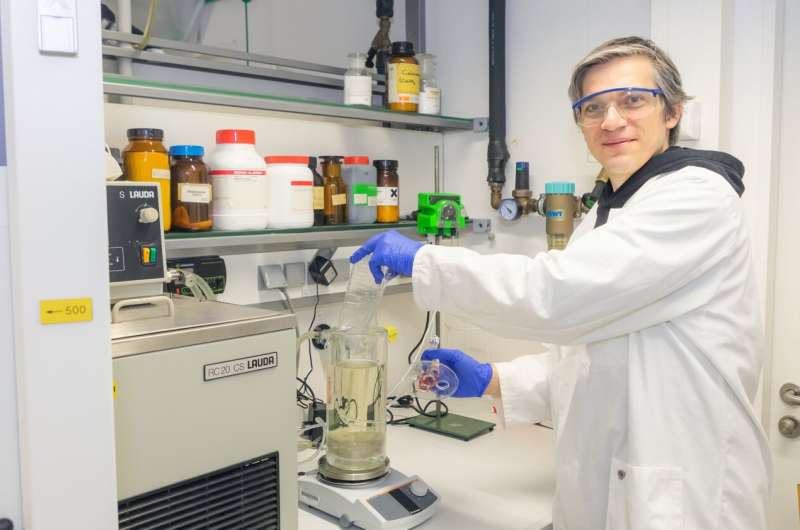
The hunt is clearly on and we will likely have to work our plastics a little differently as well eto reduce crystal size. The take home is that we will ultimately be able to treat our land fills in order to reduce plastic waste. That will be very welcome.
It is worth recalling that all natural waste completely biodegrades in the presence of even modest water. Just what do you think a forest floor is doing today?
So all we have to do is adjust our protocols in order to make sure thgat this can also happen to everything we make as much as possible. while we are waiting, we should be running all wasate through a two lung incinerator and not the single open hearth type we have used forever.
Enzyme breaks down PET plastic in record time
MAY 18, 2022
by Nina Vogt, Leipzig University
Dr Christian Sonnendecker and his team discovered an enzyme that breaks down PET plastic at record speed. Credit: Leipzig University / Swen Reichhold
Plastic bottles, punnets, wrap—lightweight packaging made of PET plastic becomes a problem if it is not recycled. Scientists at Leipzig University have now discovered a highly efficient enzyme that degrades PET in record time. The enzyme PHL7, which the researchers found in a compost heap in Leipzig, could make biological PET recycling possible much faster than previously thought. The findings have now been published in the scientific journal ChemSusChem and selected as the cover topic.
One way in which enzymes are used in nature is by bacteria to decompose plant parts. It has been known for some time that some enzymes, so-called polyester-cleaving hydrolases, can also degrade PET. For example, the enzyme LCC, which was discovered in Japan in 2012, is considered to be a particularly effective "plastic eater." The team led by Dr. Christian Sonnendecker, an early career researcher from Leipzig University, is searching for previously undiscovered examples of these biological helpers as part of the EU-funded projects MIPLACE and ENZYCLE. They found what they were looking for in the Südfriedhof, a cemetery in Leipzig: in a sample from a compost heap, the researchers came across the blueprint of an enzyme that decomposed PET at record speed in the laboratory.
The researchers from the Institute of Analytical Chemistry found and studied seven different enzymes. The seventh candidate, called PHL7, achieved results in the lab that were significantly above average. In the experiments, the researchers added PET to containers with an aqueous solution containing either PHL7 or LCC, the previous leader in PET decomposition. Then they measured the amount of plastic that was degraded in a given period of time and compared the values with each other.
The result: within 16 hours, PHL7 caused the PET to decompose by 90 percent; in the same time, LCC managed a degradation of just 45 percent. "So our enzyme is twice as active as the gold standard among polyester-cleaving hydrolases," Sonnendecker explains. For example, PHL7 broke down a plastic punnet—the kind used for selling grapes in supermarkets—in less than 24 hours. The researchers found that a single building block in the enzyme is responsible for this above-average activity. At the site where other previously known polyester-cleaving hydrolases contain a phenylalanine residue, PHL7 carries a leucine.
Biological PET recycling has some advantages compared to conventional recycling methods, which rely primarily on thermal processes where the plastic waste is melted down at high temperatures. These processes are highly energy-intensive and the quality of the plastic decreases with each recycling cycle. Enzymes, on the other hand, only require an aqueous environment and a temperature of 65 to 70 degrees Celsius for their work. Another plus is the fact that they break down the PET into its components terephthalic acid and ethylene glycol, which can then be reused to produce new PET—resulting in a closed cycle. So far, however, biological PET recycling has only been tested by a pilot plant in France.
"The enzyme discovered in Leipzig can make an important contribution to establishing alternative energy-saving plastic recycling processes," says Professor Wolfgang Zimmermann, who played a key role in establishing research activity into enzyme-based technologies at Leipzig University. "Due to the enormous problems caused by the global burden of plastic waste on the environment, it is becoming increasingly important to find environmentally friendly methods for reusing plastic in a sustainable circular economy. The biocatalyst now developed in Leipzig has been shown to be highly effective in the rapid decomposition of used PET food packaging and is suitable for use in an environmentally friendly recycling process in which new plastic can be produced from the decomposition products."
The researchers from Leipzig hope that the newly discovered enzyme PHL7 can advance biological recycling in practice and are looking for industrial partners for this purpose. They are convinced that the higher speed will significantly reduce recycling costs. Over the next two to three years, they aim to create a prototype that will make it possible to quantify the economic benefits of their rapid biological recycling process more precisely.
The scientists on Professor Jörg Matysik's team at the Institute of Analytical Chemistry also want to elucidate the structure and function of the enzymes using NMR spectroscopy. They are also working on a new pretreatment method to solve a problem in biological recycling: PET decomposition by enzymes has so far only worked for so-called amorphous PET, which is used in things like fruit packaging, but not for plastic bottles made of PET with higher crystallinity.
No comments:
Post a Comment